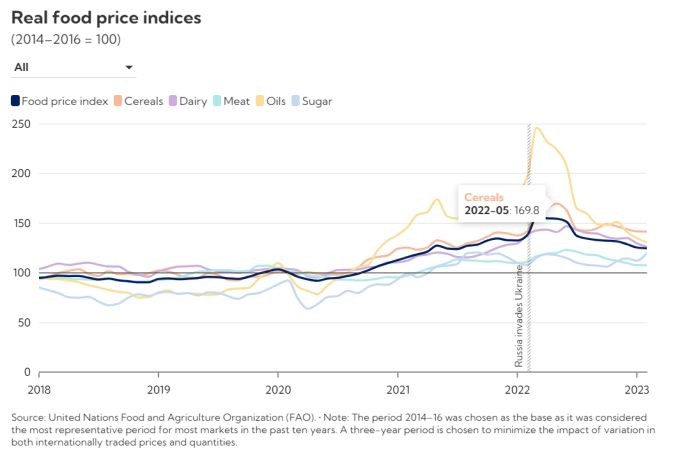- International organizations repeat joint call for rapid action on food and nutrition security
By Jeff Kearns
One year after Russia’s invasion of Ukraine upended agricultural commodity markets, food prices remain elevated even after retreating from their record highs in early 2022.
With two of the world’s largest exporters of wheat and other crucial crops entering a second year of war, many vulnerable countries still face heightened food insecurity. Fragile and conflict-affected states, home to one billion people, are at particular risk.
Eleven straight monthly declines have pushed food prices down 19 percent from a peak last March, the Food and Agriculture Organization of the United Nations said Friday.
As the Chart of the Week shows, inflation-adjusted prices in February remained above than the average level for recent years, though they are now back in line with levels seen before the war in Ukraine. The composition of the FAO Food Price Index shows that vegetable oils drove the decline in prices, along with dairy and cereals, while sugar and meat are little changed from early last year.
The IMF and other global institutions said in a recent joint statement on food security that governments and donors must step up support for the most vulnerable, facilitate trade and market functioning, and abandon harmful subsidies.
“More concerted action across these three key areas is needed to prevent a prolonged crisis,” the heads of the FAO, IMF, World Bank, World Food Programme and World Trade Organization said in a Feb. 8 statement, their third since July on the global food and nutrition security crisis.
The IMF’s new Food Shock Window has so far supported Guinea, Haiti, Malawi, and Ukraine. In addition, nine countries facing acute food insecurity benefited from IMF financial support through new or existing programs, with a focus on strengthening social safety nets and policies to help address the impact of the food crisis.





